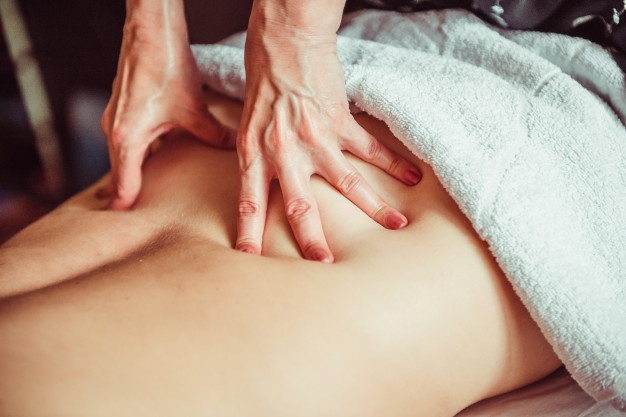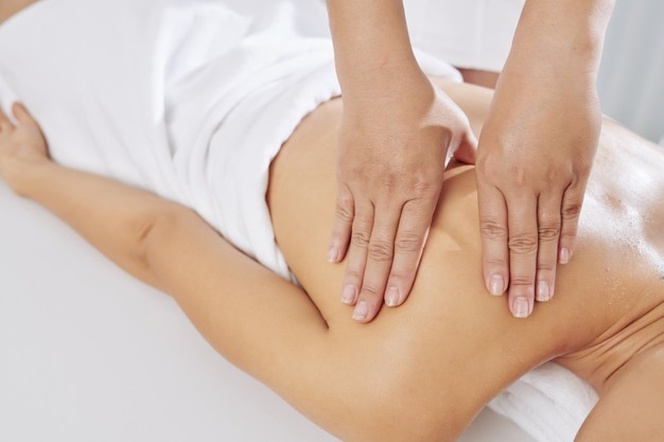- Deep Tissue Massage Techniques:
- Active release method:
- Muscle energy technique:
- Trigger point method:
- What happens during the massage?
- Benefits of deep tissue massage:
- Reduces pain:
- STRESS RELIEF:
- LOWERS BLOOD PRESSURE AND HEART RATE:
- Reduces anxiety and muscle tension:
- BREAKS UP SCAR TISSUE:
- REHABILITATES INJURED MUSCLES:
- Reduces Arthritis Symptoms:
- HELPS WITH LABOR AND DELIVERY:
- Do Deep Tissue Massages Hurt?
- Side Effects:
- Precautions:
- Final words:
Deep tissue massage is a technique used to treat musculoskeletal issues, including strains and sports injuries. It involves providing enough pressure using slow, deep strokes to target the inner layers of your muscles and connective tissues. Deep tissue massage also helps to break up scar tissue that develops following an injury and decrease tension in muscle and tissue. It may also support faster healing by enhancing blood flow and reducing inflammation.
This in-home massage technique is ideal for focusing on specific painful, stiff “trouble “pots” in your”body. Your in-home massage therapist will work with slow, deliberate strokes that offer pressure on layers of muscles, tendons, or other tissues deep under your skin. It is less rhythmic than other types of massage. But deep tissue massage may be therapeutic — decreasing chronic patterns of tension and assisting with muscle injuries, such as a back sprain.
Deep Tissue Massage Techniques:

These massage techniques break up scar tissue and physically break down muscle “knots” or” he” ions. It includes rigid tissue that can decrease circulation and create pain, reduced range of motion, and inflammation. In deep tissue massage, some of the strokes may feel the same as those used in Swedish massage therapy, but this in-home massage isn’t a sister version of a Swedish massage. Lighter pressure is generally applied to warm up at the beginning of a deep tissue massage and prepare the muscles. Common techniques include;
Active release method:
This technique is also called ART. It combines treatment and examination. The massage therapist must check your situation and medical history before beginning. They will use their hands to see how your tendons, muscles, and ligaments are developed. They will also check the composition of your muscles and see how your nerves work during the examination. The massage therapist then works with abnormal tissue with the help of coordinated pressure.
Muscle energy technique:
This deep tissue massage technique helps to stretch the muscles. This technique is used by massage therapists who deal with sportspeople and patients with specific injuries during physical therapy. This unique technique has become accepted as helpful in stretching the postural muscles that tend to shorten. The massage therapist pulls against resistance using isometric compression for progressive constriction. However, this method is unsuitable for physical muscles, but it can strengthen and relax cramping muscles. After any injury, patients can get this message at home by the spa-mobile to help their muscles recapture their capacity and decrease restricted edema.
Trigger point method:
This method is ideal for dealing with pain at its source. The massage therapist applies pressure in cycles and allows you to breathe deeply in specific ways. The purpose is to find the specific place with discomfort, measure the amount, and deal with it.
What happens during the massage?
Before your in-home massage session, your therapist will want to know about your specific areas. It can involve your entire body or just one area. During your in-home massage session, you’ll be your back or stomach under a sheet. Your massage therapist will warm up your muscles with the help of lighter touch. They’ll sThey’lling massage on your problem areas once you’re wayou’rep. A massage therapist will use deep kneading and stroking with different amounts of intense pressure.

Benefits of deep tissue massage:
In-home deep tissue massage provides both physical and psychological benefits. Unlike other massage techniques that focus on relaxation, deep tissue massage allows for treating muscle pain and improving stiffness. But it can still improve your mental health. This fantastic massage technique brings you many benefits but also helps you physically in terms of aches and stiffness. The main advantages of deep tissue massage include:
Reduces pain:
Pain relief is the most prominent and immediate advantage of a deep tissue massage. As the massage is done, it decreases the activity of inflammatory cytokines responsible for pain and inflammation. Similarly, in-home deep massage helps enhance the proteins that signal the muscles to create more mitochondria, which help muscles recover from injury and activity. If you’re deyou’rewitborn with injury, living with liver fasciitis, or have a chronic condition such as sciatica or fibromyalgia, this in-home massage can bring pain relief. Some studies have shown that deep-tissue massage is a powerful pain reliever.
STRESS RELIEF:
Deep tissue massage is beneficial in relieving stress. If you are facing stress at home or work, getting an in-home massage is the best way to unplug and relax for a more extended period. It can help decrease cortisol levels and enhance oxytocin levels, a hormone that relaxes the body and creates soothing effects. Deep tissue massage can also help with physical symptoms of stress, such as tight shoulders and tension headaches. It can address these issues and assist your body relaxes.
If you’re anyou’rete recovering from an injury or a worker with back pain, many massage advantages can assist you in getting back to living a more balanced life.
LOWERS BLOOD PRESSURE AND HEART RATE:
This in-home massage decreases stress and tension, which impacts blood pressure. It also strongly impacts systolic, diastolic, and arterial blood pressure. Deep tissue massage can also enhance the production of serotonin, which develops good feelings and happiness.
Reduces anxiety and muscle tension:
As I mentioned earlier, in-home massage is good for people dealing with poor health due to stress. This is mainly because it stimulates blood flow and decreases muscle tension. It also helps lower psychological stress and produces “happy ho”homones” like se” serotonin and oxytocin.

spa massage 1098 15858
Inflammation caused by muscle tension and chronic stress can worsen overall health. It can also cause longer recovery time, decreased immune function, and cardiovascular problems, such as high blood pressure. Research has found that in-home massage therapy can help decrease cortisol levels and even boost the production of the hormone oxytocin, which relaxes the body and has positive effects.
BREAKS UP SCAR TISSUE:
People often report chronic pain and stiffness in areas with scar tissue. Regular in-home massages can help break up this scar tissue by increasing lymphatic circulation and drainage, enhancing flexibility and range of motion in the area. Some people recovering from surgery are often advised to get deep tissue massages to decrease scar tissue.
We all know that, after an injury, and especially if it is also very difficult, inflammation can limit the amount of blood flow reaching damaged tissue and decrease main nutrients and oxygen. It can cause toxins to accumulate around the damaged tissue, which only enhances swelling and pain. In-home massage can also help reduce the pain related to plantar fasciitis and other injuries.
REHABILITATES INJURED MUSCLES:
A deep tissue massage can help if you have injured muscles by stretching tight or twisted muscles. It can also facilitate the movement of toxins from your muscles. This massage therapy is often used to deal with sports-related injuries. Many athletes consider deep tissue massage an effective tool in their recovery process, as this massage therapy can help delay the onset of muscle soreness. It also helps with muscle fatigue and prevents injuries.
Reduces Arthritis Symptoms:
According to the Arthritis Foundation, in-home massage is often used to help with typical symptoms of many types of arthritis. It includes chronic joint pain, stiffness, anxiety, limited range of motion in joints, and trouble sleeping. A therapist or patient can use deep tissue massages regularly for natural relief.
Some studies have shown that firmer massages, like deep tissue massage with more pressure, can significantly decrease arthritis pain compared to lighter massages and tendonitis and similar types of painful situations.
HELPS WITH LABOR AND DELIVERY:
Deep tissue massage helps with labour and delivery. It can help women control their pain during labour. Prenatal massages are the best way for women to relax and ease tight muscles due to pregnancy, even before labour. It can also help women to minimize depression, anxiety, and leg and back pain due to an increase in cortisol.
Studies have proven that women who get regular in-home massages before and during labour have less pain than those who do not receive regular massages. They also found that their labours were shorter than those of women who did not regularly get massages.
Do Deep Tissue Massages Hurt?
You may feel discomfort or even pain as the massage therapist deals with areas where they have adhesions or scar tissue at certain times during the massage. Pain is not a sign that the massage will be effective. Your body may develop pain in response to massage, making it difficult for the therapist to reach deeper muscles. You should tell your massage therapist if you feel pain. The therapist can alter the method or further prep the tissues if the superficial muscles are tense.
Side Effects:
The advantages of deep tissue massage are best experienced if you have a regular course of massage sessions over time. However, sometimes you need that one-off massage to deal with the troublesome knotty shoulder. You can expect to feel a little tender in the area that has been worked after a deep tissue massage. But you shouldn’t have if you think you should and discuss this with your massage therapist.
The most significant after-effects of a deep tissue massage are thirst and sleepiness. That’s why I’m cooking a deep tissue massage service at home with a Spa-mobile so that you can drink some water and go to bed soon after the massage session at night.
It’s normal to to ache or even be slightly nauseous after a deep tissue massage. This is due to toxins moving through your body. You should drink plenty of water and relax, and both of these effects will decrease with time.
Precautions:
- It’s essential importantly to your doctor to get a deep tissue massage at home if you are at risk of forming blood clots.
- If you’ve had hayou’veotherapy, radiation, or have another medical condition, it’s advised to see your doctor before starting a massage session. Similarly, people with osteoporosis should avoid the deeper pressure of this type of massage.
- Deep tissue massage should not be done directly over inflamed or infected skin, skin rashes, open wounds, tumours, abdominal hernia, or areas of recent fractures.
- If you have any conditions, it’s important to consult your primary care provider first to find out what type they recommend. For instance, people with certain conditions, such as spondylitis, may not be able to handle the pain of a deep-tissue massage.
Final words:
Deep tissue in-home massage is more than just a massage with increased pressure. The purpose and methods are different from a Swedish massage. While it may assist with many conditions, remember that in-home massage doesn’t adoesn’tavehave make your body sore to be effective. Talk with our massage therapist at the spa-mobile to get the most out of your in-home massage session.

